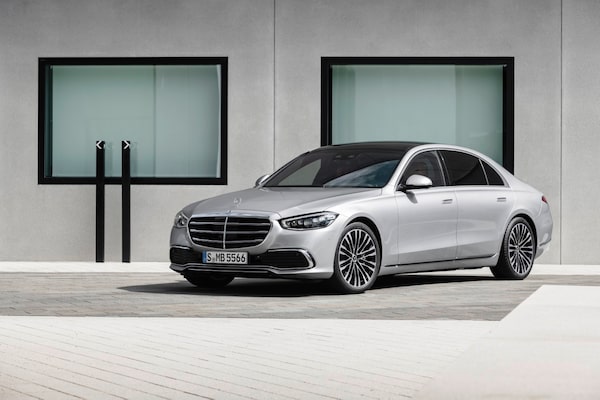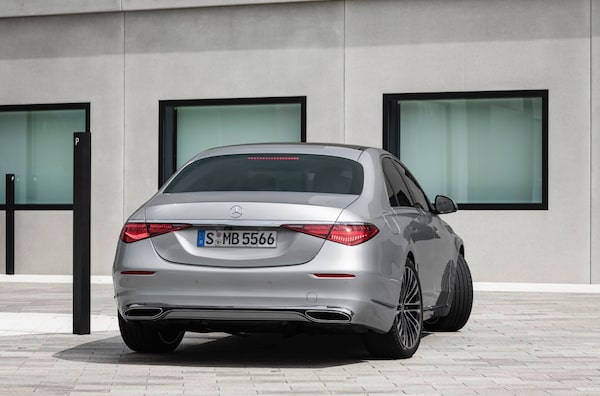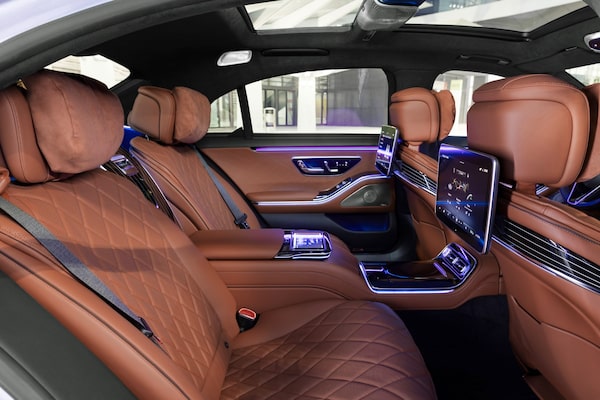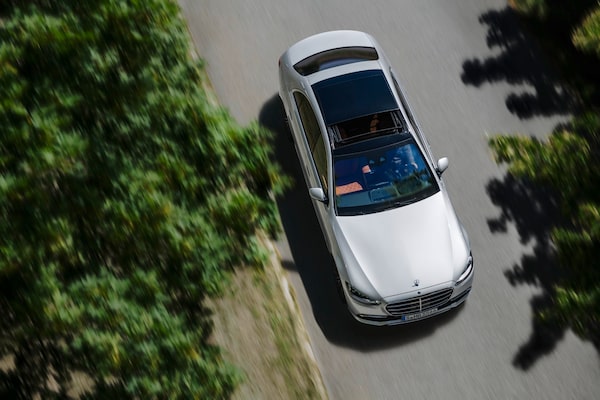
Mercedez-Benz has revealed the new 2021 S-Class luxury sedan.Mercedes-Benz AG - Global Communications Mercedes-Benz Cars & Vans/Courtesy of manufacturer
Science-fiction visions of the automobile’s future suddenly seem closer to reality with the new luxury flagship S-Class sedan from Mercedes-Benz.
It can’t fly, nor is it fully electric – not yet at least – but the new 2021 S-Class can do sci-fi things like monitor drivers’ body language to intuit their desires, turn the windshield into an augmented-reality display and make 2-D screens appear 3-D through the use of eye-tracking technology.
The company is aiming high with this one. “The new S-Class underpins our claim to produce the best automobile in the world,” Markus Schaefer, member of the board of management of Mercedes-Benz AG, said in a statement.
As its flagship model, the S-Class sets the template for Mercedes-Benz vehicles for years to come. The brand is going all-in on big screens, smart technology and automated driving; many of the features and design cues seen here will eventually trickle down to other models.

As the automaker's flagship vehicle, the S-Class's styling cues and technology is likely to trickle down to other models.Mercedes-Benz AG - Global Communications Mercedes-Benz Cars & Vans/Courtesy of manufacturer
The German company took the wraps off its new full-size sedan in a digital event – a video stream with interactive elements – the likes of which have quickly replaced car shows during the pandemic. Attendees watched musician Alicia Keys talk about the new stereo and saw six-time Formula 1 champion Lewis Hamilton explain how this car makes him feel relaxed.
The S-Class is the darling of the C-Suite and the vehicular equivalent of a big Rolex chronograph or a chunky pair of Oliver Goldsmith glasses. The model’s history can be traced back to the early 1950s, but the S-Class name wasn’t introduced until 1972. Its main rivals include the BMW 7 Series, Audi A8, Porsche Panamera and the Lexus LS. These days, Tesla’s Model S is more of a competitor to the big Benz than any sedan from Cadillac or Lincoln.
More than one third of S-Classes are sold in China, according to Mercedes. Worldwide, nine out of 10 customers opt for the stretched, long-wheelbase version. And, once people buy into an S-Class, the vast majority remain loyal to Mercedes-Benz for their next vehicle.
“What matters to our customers are beautiful design and extraordinary automobiles,” Gordon Wagner, the company’s chief design officer, said during the digital unveiling. Minimalism is the true luxury of our time, he added.
Seen from the outside, the new S-Class hardly looks new, let alone groundbreaking. Subtle things like the smoother, simpler bodywork, new lights and flush door handles distinguish it from its predecessor. The new model is more spacious and bigger in every nearly dimension, but it would take a keen eye to notice.

New lights and bodywork help subtly distinguish the new model from its predecessor.Mercedes-Benz AG - Global Communications Mercedes-Benz Cars & Vans/Courtesy of manufacturer
Sit inside the new S-Class – even virtually – and it looks as if it comes from the future. A single piece of wood trim inlaid with aluminum pinstripes flows across the dashboard and back around the doors.
It’s clearly a product of the wellness era, promising to pamper occupants with “energizing comfort programs.” One of which, Joy, is said to generate good feelings and reduce stress through sound, ambient light and massaging seats. All you need to do to turn it on is say something like, “Hey Mercedes, I’m stressed.”

The luxuriously appointed interior offers 'energizing comfort programs' for drivers and passengers.Mercedes-Benz AG - Global Communications Mercedes-Benz Cars & Vans/Courtesy of manufacturer
As with your smartphone, there are few physical buttons in the S-Class, and it can recognize you by your fingerprint, voice or even your face. There are up to five screens in the cabin, running Mercedes’ next-generation MBUX infotainment system.
An enormous heads-up display – equivalent to the size of 77-inch screen – projects augmented reality (AR) info to the driver. Instead of a left turn symbol for navigation, for example, drivers now see an animated arrow projected over the environment that moves in real-time with the car.
There is a risk that so many screens could end up distracting – rather than helping – the driver, so it will be crucial to see how it works in practice.
Beginning next year in Germany, the S-Class will gain a Level 3 automated-driving mode supported by a LIDAR sensor. But, we’ve seen other automakers, namely Audi and Tesla, make bold claims about next-level automated-driving features; in both cases, these features have yet to materialize.

The cabin can feature up to five screens running on the MBUX infotainment system.Mercedes-Benz AG - Global Communications Mercedes-Benz Cars & Vans/Courtesy of manufacturer
Notably absent is an all-electric S-Class. Such a car is in the works, however, with 700 kilometres of driving range, as previewed by last year’s EQS concept car, said Mercedes chairman Ola Kaellenius. A plug-in hybrid S-Class with around 100 kilometres of electric range will join the S-Class lineup eventually as well.
In Canada, higher-end Mercedes vehicles like the S-Class have continued to perform relatively well in the sales charts despite current challenges and uncertainty, according to David Sherrard, national manager for product management at Mercedes-Benz Canada.
When the first new S-Classes arrive here next Spring, Mercedes will sell the S 500 (short wheelbase) and the S 580 (long wheelbase); both are expected to have all-wheel drive. They’re powered by a straight-six and a V8 gasoline engine respectively. The price has yet to be announced, but the current S-Class starts at $109,000.

The S-Class will be available in short-wheelbase and long-wheelbase versions.Mercedes-Benz AG - Global Communications Mercedes-Benz Cars & Vans/Courtesy of manufacturer
This is just the tip of the technological iceberg when it comes to the palatial new flagship sedan from Mercedes, which was detailed in a 77-page, 30,000-word document released by the company. (For reference, the Magna Carta was less than 5,000 words.)
Drivers will surely be hoping the car’s manual is considerably shorter. It’s one thing to tout lots of a cool new sci-fi technology; it’s quite another for it all to work well in the real world.
Shopping for a new car? Check out the Globe Drive Build and Price Tool to see the latest discounts, rebates and rates on new cars, trucks and SUVs. Click here to get your price.
Stay on top of all our Drive stories. We have a Drive newsletter covering car reviews, innovative new cars and the ups and downs of everyday driving. Sign up for the weekly Drive newsletter, delivered to your inbox for free. Follow us on Instagram, @globedrive.